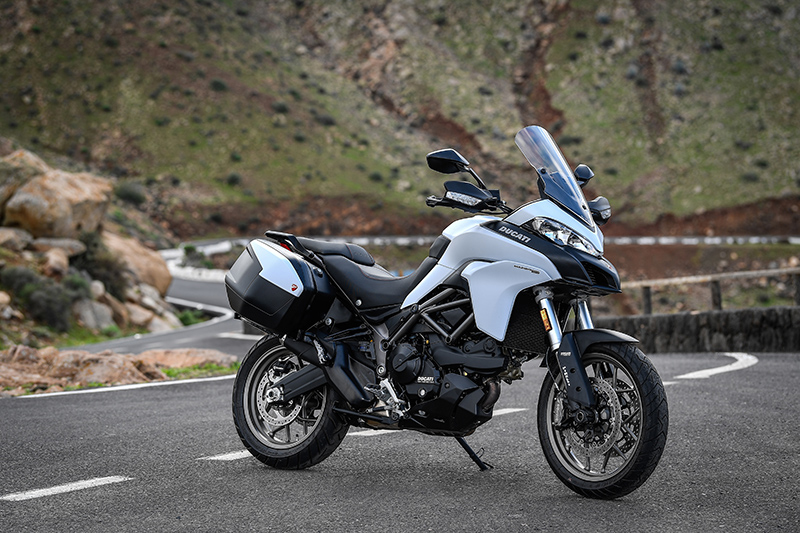2017 Ducati Multistrada 950

First Ride Review
The 2010 redesign of the Ducati Multistrada transformed it from a narrowly focused sit-up sportbike into a full-fledged adventure tourer, opening the storied Italian brand to legions of riders who wouldn’t—or couldn’t—consider its bikes in the past. As long as you’ve got the wallet and leg length for it, the latest Multistrada 1200 DVT offers 160-horsepower performance in a sit-up, wind-protected touring cocoon that shames sportbikes in the corners, navigates dirt roads fairly well and uses the latest electronic rider aids for the suspension, engine and brakes to enhance the ride and safety. Outside of Ducati’s newish entry-level Scrambler family, today the Multistradas are Ducati’s bestselling bikes, a position only strengthened with the addition of the new Enduro variant (that takes some of the pressure off the base model to satisfy serious ADV riders).
There’s really only one thing the big Multis have lacked, in fact—a little brother. For some riders the 1200s’ cost, size and even their complexity make them too exotic for consideration—highly desirable but not practical, like a Porsche Cayenne vs. a Nissan Pathfinder. So Ducati has taken the Testastretta 11° liquid-cooled, 937cc L-twin from the Hypermotard and new Supersport and wrapped it in a tighter, simpler adventure-bike package to create the Multistrada 950, which like the Enduro runs a 19-inch front wheel vs. a 17.
With a claimed 113 horsepower at 9,000 rpm and 71 lb-ft of torque at 7,750, the 950 engine’s output is right in the sweet spot for a do-it-all machine that weighs a claimed 500.4 pounds (tank 90 percent full), about 40 pounds less than the Multistrada 1200 DVT S. Ducati says more than 80 percent of that torque is on tap from 3,500 to 9,500 rpm (redline is 10,500), a claim that’s easy to believe after flogging the bike for about 150 miles in the desert and mountains of Fuerteventura, one of the Spanish Canary Islands. Peak power, acceleration and low-end grunt are thrillingly ample, and the 950 is smoother at low speeds than its big brother, even without the benefit of desmodromic variable valve timing (DVT), which its smaller pistons don’t require. Power delivery is just as satisfying too, since what the 950 lacks in sheer thrust it makes up for with a visceral but controllable snap on hard throttle that sounds and feels like ripping velvet. Some vibration creeps into the seat above about 5,000 rpm, but the bike cruises along smoothly at just 4,000 rpm at 60 mph, and the hand grips and cleated steel footpegs with rubber inserts never get shaky.
Like the 1200, the 950 offers throttle-by-wire with four riding modes—Sport, Touring, Urban and Enduro—with full power always on tap in the first two and the urge reduced to 75 horsepower in the city and off-road modes. Changing riding modes while stopped or on the fly also automatically adjusts the 3 levels of Bosch 9.1 MP ABS and 8 levels of Ducati Traction Control (DTC) to suit each riding mode, and the rider can personalize and save the settings or even turn the intervention off. Touring and Urban modes get more intervention, and Sport and Enduro less (and the rear wheel can be locked in Enduro). All of this works seamlessly and is displayed on the excellent LCD display, and Ducati got the snappy response of Sport mode and softer delivery of Touring mode just right, though changing modes underway takes longer than it should. To reduce cost and complexity, the 950 makes do without a multi-axis inertial measurement unit and the features it enables on the bigger bike like cornering ABS and wheelie control. Its Brembo triple disc brakes with opposed four-piston calipers and a radial master cylinder up front are quite strong and linear however, and offer excellent feel.
Though it has the same steel trellis frame as the other Multis, the 950 wears a double-sided cast alloy swingarm vs. the 1200’s single-sider, and the 950’s 19-inch front wheel gives the bike slightly more ground clearance for off-road work, not to mention a bit more stability in the dirt vs. the 1200’s 17-incher. Squint and you might mistake the new Y-spoke cast alloy wheels for wire spoked wheels—they’re shod with Pirelli Scorpion Trail 2 tires that offer a little off-road capability with loads of on-road grip. Wheels float over the road surface on a stout, 48mm KYB upside-down front fork and Sachs single shock, both fully adjustable, with a handy remote knob in back for spring preload changes. Both ends have 6.7 inches of travel, the same as the larger Multibike. I spent all day with the suspension set to standard front and rear, and despite some pretty aggressive riding never felt the need to dial in more spring or damping (though a little less front-end dive under hard braking would be nice). Overall the Multistrada 950 offers a very good ride on-road despite having a fully manual suspension setup. We didn’t do any off-road riding on this trip, and now that it has the 1200 Enduro model Ducati says that neither the 1200 nor 950 should be considered first for their off-road ability, if at all, despite the 950’s 19-inch front wheel. Perhaps its primary benefit is more tire choices, by itself a good enough reason to fit it.
Ergonomically the 950 has the same rider triangle as the 1200 and feels just as relaxed but purposeful as its bigger brother, with feet positioned under the roomy seat, a wide, high handlebar and ample legroom underway provided by the tallish 33.1-inch seat height. With my 29-inch inseam I was on tiptoes at stops, but the bike’s lighter weight makes it fairly easy to maneuver in tight spots, and Ducati offers an accessory 32.3-inch low seat. The narrow windscreen adjusts up and down about 4 inches with one hand and does a decent job of keeping the wind off your chest at speed, though I didn’t notice much change in the moderate noise it creates with it up or down. Standing up on the bike is easy and seated the rider fits into it as much as on it, with the wide bar creating plenty of leverage for steering that 19-inch front hoop. Wheelbase is up by 2.6 inches over the 1200, and the 950 has 25.2 degrees of front-end rake vs. the 1200’s 24, so handling is a bit slower, but the 950 will still please even the fastest riders in the corners with its low-effort steering and predictable manners.
I found the 950 to be very approachable, especially since its more limited controls are easy to figure out, set and forget, and all of the settings can be changed from the handlebar. In addition to showing the modes and menus for the bike’s various functions, the LCD display has a trip computer, fuel gauge, gear indicator and clock. There’s a small storage space under the locking rear seat (the front bolts on) as well as a USB charging port and DIN socket for accessories, and another DIN socket up front. It was especially thoughtful of Ducati to include four bungee hooks under the tailsection, too. Mirrors work reasonably well, but due to the cable-actuated clutch the bike only has an adjustable brake lever, and the adjuster was difficult to use on our test bike. Service intervals for the Multis are higher now, at 18,000 miles for desmo valve checks and 9,000 miles for oil changes.
Ducati wisely fit the 1200’s useful rear rack to the 950, so top trunks, etc., are interchangeable, and a centerstand and color-matched techno polymer panniers are available in a $1,287 accessory Touring Pack for both the Ducati Red and Star White (add $200) paint colors. Sport, Urban and Enduro accessory packs that are all compatible with one another are available as well, and the $1,849 aluminum panniers for the 1200 Enduro will also fit the 950.
With its lower cost of ownership, less intimidating but ample performance, versatility, capability and comfort for daily use and all kinds of riding, for many the Multistrada 950 will be the Ducati that’s not too small, not too big, but just right. We’ll have more when we get one stateside for a full test.
